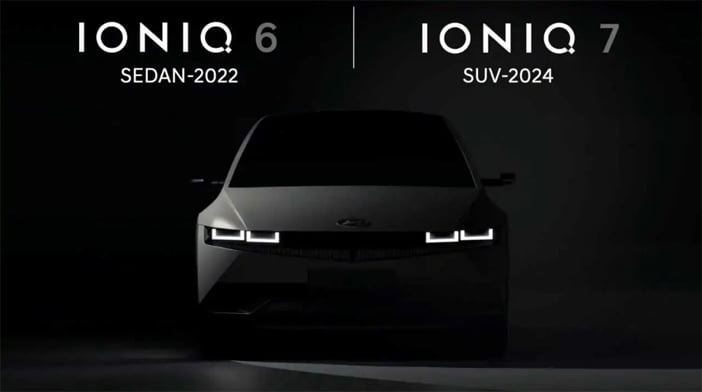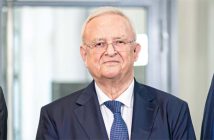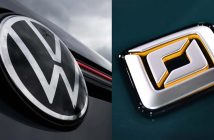+++ The car market in EUROPE grew by 261 % year-over-year in April 2021 (to 1.029.008 units), however, it’s down 23 % compared to April 2019 and remains the second lowest in 20 years. JATO Dynamics’ report reveals also that the plug-in electric car segment is up significantly, taking 15 % of the market (compared to 11 % a year ago). Here is the breakdown between plug-in hybrids and all-electric cars: BEVs: 71.500 (up 338% year-over-year) and PHEVs: 81.000 (up 507% year-over-year). According to JATO Dynamics’ data, the topselling electric car in April was the Volkswagen ID.4. The second-best was the Volkswagen ID.3. Felipe Munoz, global analyst at JATO Dynamics commented: “As anticipated, the next phase of growth for EVs is going to come from SUVs. The Volkswagen ID.4 taking the lead is just the beginning of the electric-SUV trend, and we expect new models to enter the market as consumer demand increases”. An interesting thing is that the Volkswagen Group managed to expand its share in the all-electric segment to 34 %. “In fact, BEVs are offsetting the losses posted by Volkswagen’s traditional ICE models. For example, the Volkswagen Golf was the third best-selling model in the overall rankings as its volume decreased by 49 % between April 2019 and April 2021. In April 2018, the Golf accounted for 2.93 % of all new car registrations compared with just 1.73 % last month”. An industry analyst Matthias Schmidt notes that the 12-month cumulative average of Volkswagen Group all-electric car sales in Western Europe is now at over 200.000, while Tesla (the global market leader (former European BEV leader) and the main point of reference) is stuck at 100.000. Lacking the reinforcements in the form of the Model Y and the fade of Model S / Model X (awaiting refreshed versions) make it difficult to grow despite the fact that the overall market is growing fast. +++
+++ By way of the Ioniq 5 introduction, HYUNDAI announced that there is more to come. The company has confirmed 2 additional, dedicated all-electric models. The first is a midsize electric saloon (the Ioniq 6) that will enter the market in 2022. It will be based on the Hyundai Prophecy Concept. The second one is a large electric SUV (the Ioniq 7) scheduled for 2024. Most likely, a 3-row SUV. At this point we don’t know any details, but if the Ioniq 5 is ready for up to 483 km of range, the 6 and 7 might get more: 640 km or more in top versions. Let’s recall that the Ioniq 5 will enter the market in Fall 2021 (in the initial batch of states) and then spread in 2022. The Hyundai Motor Group intends to increase the number of all-electric cars on the market to 23 and sell 1 million BEV units worldwide by 2025. That should provide a steady stream of new models. +++

+++ MAZDA ’s upmarket push partly hinges on a new rear-wheel-drive architecture developed in-house. It’s scheduled to enter production in 2022 and an upcoming crossover called CX-50 will inaugurate it. The CX-50 will make its global debut at the Los Angeles auto show, which will tentatively open its doors on November 19. I haven’t seen the new crossover yet, but insiders stressed Mazda wants to reap the rewards of going through the trouble of creating a rear-wheel-drive platform by giving the CX-50 a short front overhang and a long hood. Its silhouette will be sportier than the CX-5’s, and it will be the ideal backdrop on which to paint the next evolution of the elegant Kodo design language. Building the CX-50 on rear-wheel-drive bones will allow Mazda to install its new straight-6 engine between the fenders. Gasoline- and diesel-powered models will be available, though we’re highly unlikely to receive the latter. The 2 engines will have a displacement of 3.0 and 3.3 liters, respectively, according to the same source. Both will spin the rear wheels via an 8-speed automatic transmission, and all-wheel-drive will be optionally available. The 6-cylinders will work with 48 volt mild hybrid technology. The palette of available powertrains will also include a plug-in system built around a 2.5-liter 4-cylinder, but it doesn’t sound like SkyActiv-X engines will be offered. Mazda has confirmed it’s about to add a rear-wheel-drive architecture to its arsenal, though it hasn’t revealed how or when we’ll see it. If the report is accurate, the Japanese firm will begin publishing details about the CX-50 in the coming months, and it will unveil the model in November 2020. Looking ahead, the platform will also underpin the successor to the Mazda6, which will be discontinued in the United States at the end of the 2021 model year. Lower-volume models, including a crossover with a coupe-like roofline, are in the pipeline as well, but they’ll come after Mazda renews its core range of cars and completes the leap upwards. Ultimately, the plan’s success largely depends on how new products like the CX-50 are received in key markets, like the United States and China. The CX-5 won’t get pushed out of the line-up by the CX-50. It will receive a round of updates in the not-too-distant future and carry on as a cheaper alternative to avoid alienating customers who want a Mazda without paying for a luxury car. Older engines and a front-wheel-drive platform will differentiate it from the CX-50. +++
+++ If you’re one of the reservation holders who’ve been patiently waiting for your new 2022 RIVIAN R1T electric pickup, be prepared to hold out just a little bit longer. In a blog post highlighting new equipment for the R1T, Rivian announced that it would be delaying the EV truck’s production by another month. First deliveries of 2022 R1T Launch Edition models will now begin in July instead of June, the automaker says. This is the most recent delay for the R1T after the COVID-19 pandemic delayed production from late 2020 until the summer of 2021. The delay will effectively extend production of the R1T Launch Edition through the spring of 2022, after which we expect R1T Adventure and Explore Package electric pickups will become available. No word on how this affects Rivian R1S production. R1S deliveries were supposed to begin in August of 2021. It’s a safe bet that those deliveries will be delayed at least another month as well. While the delay is certainly bad news for R1T and R1S buyers, the automaker did announce some product updates that’ll hopefully make the extra wait worth it. Now standard on all Rivians is an onboard air compressor, making airing down and back up again while off-roading (as well as inflating camping accessories like air mattresses) that much easier. Rivian also made the Off-Road Upgrade optional, instead of standard on Launch Edition and Adventure Package vehicles (it’ll remain optional on cheaper Explore models). The company has also announced that a handful of Rivian Adventure Gear accessories are now live in its configurator. This includes cargo crossbars for the bed, a three-person tent that can mount on it, racks for bikes, kayaks, surfboards, and snowboards/skis, off-road recovery gear, among other things. Rivian still looks like it will win the race to bring the first modern long-range electric pickup truck to market. Hot on the R1T’s heels is the 2022 GMC Hummer EV Pickup, which is expected to go into production by this winter. The Ford F-150 Lightning, which was revealed last week, is slated to hit dealers in the spring of 2022. The Tesla Cybertruck likely won’t go on sale until late 2022 at the earliest, though some deliveries recently were promised by the end of 2021. +++
+++ ROLLS-ROYCE last year trademarked the name Silent Shadow with the German patent office, and that moniker is likely to be applied to the British luxury carmaker’s upcoming battery electric vehicle. In an interview, Rolls-Royce CEO Torsten Müller-Ötvös confirmed that the company is working on a purpose-built EV. While he would not reveal the scheduled launch date, Rolls-Royce has previously said an EV model would arrive before the end of the decade. The Silent Shadow name echoes the Silver Shadow of 1965-1980. Although Rolls-Royce has previously ruled out doing a plug-in hybrid, the German-owned British automaker has been inching toward full-electric vehicles for some time. At the 2011 Geneva auto show, it introduced an electric version of the last-generation Phantom named 102EX. More recently in 2016, it unveiled the stunningly futuristic 103EX concept, which was fully electric. “Electrification fits perfectly with Rolls Royce. It’s torquey, it’s super-silent”, Müller-Ötvös said. It’s true that, at Rolls-Royce, the sound of the car’s engine has never been a selling feature. Instead, the brand has long promised near-silent motoring. Indeed, a 1958 ad for Rolls-Royce by advertising legend David Olgivy, makes a claim to the car’s quietness. And that ad has become what many consider to be the most famous auto ad of all time: “At 60 miles an hour the loudest noise in this new Rolls-Royce comes from the electric clock”. Maybe they’ll want to revisit that claim when the Silent Shadow makes its debut. +++
+++ 2 key groups that offer automobile safety ratings are yanking their top endorsements from some TESLA vehicles because the company has stopped using radar on its safety systems. Consumer Reports pulled its ‘Top Pick’ status for Tesla’s Model 3 and Y vehicles built after April 27, while the Insurance Institute for Highway Safety plans to remove the vehicles ‘Top Safety Pick Plus’ designation. The U.S. government’s National Highway Traffic Safety Administration is no longer giving the Models 3 and Y check marks on its website for having forward collision warning, automatic emergency braking, lane departure warning and emergency brake support. That prompted the ratings groups’ actions. Both require electronic safety systems for the top safety designations. Consumer Reports says that removing radar and relying on cameras means the safety features may not be there when needed. A message was left seeking comment from Tesla, which has disbanded its media relations department. “If a driver thinks their vehicle has a safety feature and it doesn’t, that fundamentally changes the safety profile of the vehicle”, David Friedman, Consumer Reports’ vice president of advocacy, said in a statement. “It might not be there when they think it would save their lives”. IIHS confirmed that it pulled the Top Safety Pick Plus designation, but said it remains for vehicles built with radar. The institute said it plans to test Tesla’s new system. Tesla says on its website that it’s making a transition to a new system called “Tesla Vision” that uses cameras, on Model 3s and Ys to be delivered starting in May. The new system will use cameras and Tesla’s neural network computer processing for safety systems, as well as Tesla’s “Autopilot” and “Full Self-Driving” partially automated driver-assist systems. Tesla also has short-range sonar sensors. CEO Elon Musk has said that the 8-camera vision system works better than the best human drivers, and is a step toward the company’s self-driving ambitions. But critics have said that even with radar, Tesla doesn’t have the right sensors for self-driving vehicles. It doesn’t have laser sensors called lidar, which can see through darkness and bad weather, they say. Most other companies testing autonomous vehicles use lidar. Tesla’s Autopilot system has had trouble spotting fixed objects and tractor-trailers turning in front of its vehicles. At least 3 people have been killed while driving on Autopilot when their cars crashed beneath trailers or into a highway barrier. In addition, Teslas on Autopilot have struck police cars and firetrucks parked on freeways with their flashing lights on. NHTSA, the government safety agency, has investigated 29 incidents involving Teslas, but so far the agency has not taken action on Autopilot. The National Transportation Safety Board has recommended that NHTSA and Tesla limit Autopilot to roads where it can operate safely, and that Tesla install a better system to make sure drivers are paying attention. Tesla, which is based in Palo Alto, California, says on its website that some vehicles may be delivered with some safety features temporarily “limited or inactive”, Those include Autosteer, which keeps cars in their lanes. It will be limited to 120 km/h and a longer distance from traffic in front of the vehicle. Musk also has been criticized by Consumer Reports and others for calling his systems Autopilot, which implies that a car can drive itself, and “Full Self-Driving”, which the company says cannot drive on its own. +++
+++ According to a recent report, a fire started overnight at the ongoing construction site for TESLA ‘S UPCOMING FACTORY IN BERLIN . The German Gigafactory will be Tesla’s first production facility in Europe, and it’s set to open later this year. However, there have been many setbacks to an official opening date, and the recent fire could work to complicate the situation further. The investigation is looking into whether the fire was actually a case of arson, and more specifically, one with political implications. This is due in part to a group of radical left activists who have already publicly claimed responsibility for the fire at Tesla’s future factory site. The target of the fire was multiple power lines that head into the Tesla facility. However, the total area damaged by the fire is thankfully only about 3 square metres. The information came from a spokesperson representing the LKA state criminal investigation office. The LKA official made it clear that arson isn’t being ruled out. Instead, investigators are looking into a letter that made its way onto social media. The reported letter was first published on a far-left media platform. According to the LKA spokesperson, it said the group cut Tesla’s power supply by setting fire to “six high-voltage cables above ground”. The letter also said, “Tesla is neither green, ecological nor social”. Tesla has been up against plenty of opposition in Germany, especially from environmentalists. Hopefully, we’ll have some specifics to share as the investigation unfolds. This is a developing story, as there is an investigation underway. As more details become available, we will either update this article or provide future articles with substantiated details. +++
+++ VOLKSWAGEN has partnered with the city of Carmel, Indiana, to use machine-vision software to make traffic flow better. The partnership will see VW analyze street usage patterns to help vehicles move better through the city. The idea came from software developed for VW’s plant in Wolfsburg, Germany. The technology was intended to help optimize production and conduct automated quality checks on vehicle assembly and logistics. As the world’s biggest automotive plant, the technology had to be able to keep track of a campus that at 6.5 square kilometers (2.5 sq mi), or three times bigger than the nation of Monaco. So the automaker decided to see if it could make traffic run more smoothly in a city. “We see our tool as an opportunity to provide cities with more usable data on mobility to help shape their future transportation needs, from pedestrians and vehicle drivers through public transit”, said Johan de Nysschen, chief operating officer at Volkswagen Group of America. “We’re grateful to the City of Carmel for partnering in this shared research effort”. The system will take advantage of cameras that have already been installed around Carmel at key intersections to glean information about the traffic flow of cars and bicycles, pedestrian movement, and other data. Volkswagen hopes to give that information to city planners to help them identify trends and react to traffic. “With enhanced software from Volkswagen, Carmel can more easily expand our view of traffic flow throughout the city”, said Jim Brainard, Mayor of the City of Carmel, Indiana. “As we plan for public transportation needs in our future, our ability to capture more sophisticated information will help us make better decisions”. The tech could also be used to help emergency responders avoid traffic or get to a location in the event of a natural disaster. And if it does make regular traffic flow better, there’s an environmental advantage to getting cars to their destination more quickly. This is the first project like this for Volkswagen, but the automaker says it is in talks with other cities globally about a variety of transportation solutions. +++



